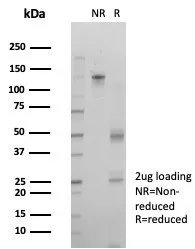Free Shipping in the U.S. for orders over $1000. Shop Now>>

SDS-PAGE Analysis of Purified IRF3 Mouse Monoclonal Antibody (PCRP-IRF3-4D7). Confirmation of Purity and Integrity of Antibody.

Flow Cytometric Analysis of PFA-fixed HeLa cells. IRF3 Mouse Monoclonal Antibody (PCRP-IRF3-4D7) followed by goat anti-mouse IgG-CF488 (blue); unstained cells (red).

Formalin-fixed, paraffin-embedded human tumor of unknown origin stained with IRF3 Mouse Monoclonal Antibody (PCRP-IRF3-4D7).

Analysis of Protein Array containing more than 19,000 full-length human proteins using IRF-3 Mouse Monoclonal Antibody (PCRP-IRF3-4D7). Z- and S- Score: The Z-score represents the strength of a signal that a monoclonal antibody (MAb) (in combination with a fluorescently-tagged anti-IgG secondary antibody) produces when binding to a particular protein on the HuProtTM array. Z-scores are described in units of standard deviations (SD's) above the mean value of all signals generated on that array. If targets on HuProtTM are arranged in descending order of the Z-score, the S-score is the difference (also in units of SD's) between the Z-score. S-score therefore represents the relative target specificity of a MAb to its intended target. A MAb is considered to specific to its intended target, if the MAb has an S-score of at least 2.5. For example, if a MAb binds to protein X with a Z-score of 43 and to protein Y with a Z-score of 14, then the S-score for the binding of that MAb to protein X is equal to 29.
Interferon regulatory factor-1 (IRF-1) and IRF-2 have been identified as novel DNA-binding factors that function as regulators of both type I interferon (interferon-αand β) and interferon-inducible genes. The two factors are structurally related, particularly in their N-terminal regions, which confer DNA binding specificity. In addition, both bind to the same sequence within the promoters of interferon-αand interferon-βgenes. IRF-1 functions as an activator of interferon transcription, while IRF-2 binds to the same cis elements and represses IRF-1 action. IRF-1 and IRF-2 have been reported to act in a mutually antagonistic manner in regulating cell growth; overexpression of the repressor IRF-2 leads to cell transformation while concomitant overexpression of IRF-1 causes reversion. IRF-1 and IRF-2 are members of a larger family of DNA binding proteins that includes IRF-3, IRF-4, IRF-5, IRF-6, IRF-7, ISGF-3γp48 and IFN consensus sequence-binding protein (ICSBP).
There are no reviews yet.